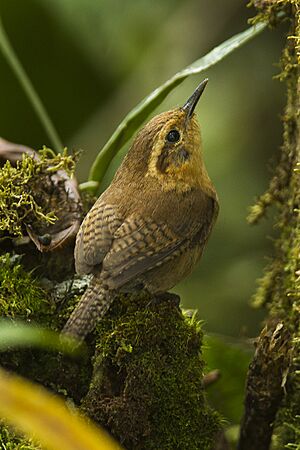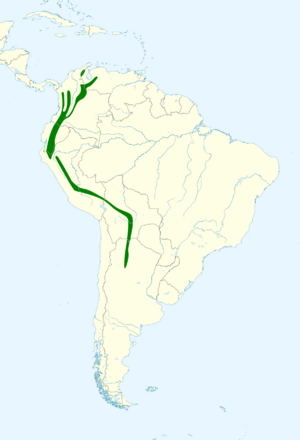Mountain wren facts for kids
Quick facts for kids Mountain wren |
|
|---|---|
 |
|
| In Ecuador | |
| Conservation status | |
| Scientific classification | |
| Genus: |
Troglodytes
|
| Species: |
solstitialis
|
 |
|
The mountain wren (Troglodytes solstitialis) is a small, active bird that lives in the Andes mountains. You can find it in countries like Argentina, Bolivia, Colombia, Ecuador, Peru, and Venezuela. It's part of the wren family, known for their lively songs and busy movements.
Contents
About the Mountain Wren Family
Scientists sometimes group the mountain wren with a few other wren types. These include the Santa Marta wren and the ochraceous wren. They are all considered part of a "superspecies." This means they are very closely related birds.
The mountain wren itself has five different kinds, called subspecies:
- T. s. solitarius
- T. s. solstitialis
- T. s. macrourus
- T. s. frater
- T. s. auricularis
What Does a Mountain Wren Look Like?
Mountain wrens are small birds, about 10.5 to 11.5 centimeters (4 to 4.5 inches) long. They weigh around 11.8 grams (0.4 ounces).
The main type of mountain wren has a reddish-brown head and back. Its tail is also reddish-brown with thin black stripes. When its wings are folded, they look striped too. It has a light brown stripe above its eye and darker brown cheeks.
Its throat and chest are a warm, light brown color. The belly is even lighter. Its sides are brownish with darker stripes. Young mountain wrens look a bit duller. Their underparts are grayish-brown with small dark spots.
Different subspecies have small differences in their looks. For example, some might have darker backs or lighter throats. Others might have longer tails or whiter stripes above their eyes.
Where Do Mountain Wrens Live?
Each type of mountain wren lives in specific parts of the Andes:
- T. s. solitarius lives in the mountains of Colombia and western Venezuela.
- T. s. solstitialis is found from southern Colombia through Ecuador into northwestern Peru.
- T. s. macrourus lives on the eastern side of the Peruvian Andes.
- T. s. frater is found in southeastern Peru and western Bolivia.
- T. s. auricularis lives in northwestern Argentina.
These wrens prefer to live in humid montane forests and cloud forests. They also like the edges of these forests, up to the tree line. Sometimes, you might find them in bamboo patches. They usually live at high elevations, between 1,700 and 3,500 meters (5,600 and 11,500 feet) above sea level. In Argentina, they can be found as low as 700 meters (2,300 feet).
Mountain Wren Behavior
How Mountain Wrens Find Food
Mountain wrens usually look for food in pairs or small family groups. Sometimes, they join other bird species to hunt together. They mostly search for food in low plants and bushes. However, they also climb into mossy trees to find insects. Scientists haven't published a detailed list of what they eat yet.
Reproduction
Mountain wrens can breed almost any time of year in Colombia and Peru. In Bolivia, they breed between November and February. Their nests are often large and made of root fibers. They have a side entrance and are lined with dry leaves. Female wrens usually lay two to five eggs.
Mountain Wren Sounds
The mountain wren's song is quiet and pretty. It sounds like a series of high notes, like "treee-treeee-tititiki." Their calls are often repeated, sounding like "dzz" or "di-di."
Status of the Mountain Wren
The IUCN (International Union for Conservation of Nature) has listed the mountain wren as a species of "Least Concern." This means that its population is stable and not currently at risk. It is common in many suitable habitats across its range. It also lives in several protected areas, which helps keep its numbers strong.


